On the Specimen Design, Physical Properties and Geometry Effect on Heat Generation and Thermal Gradient in Ultrasonic Fatigue
Abstract
1. Introduction
2. Analytical Formulation and Discussion
2.1. The Effect of Specimen Geometry on the Specimen’s Natural Frequency
- D1: Increasing D1 will greatly improve specimen stiffness, resulting in a higher natural frequency. Moreover, increasing D1 will also increase the specimen cross section, reducing its stress amplitudes.
- D2: When D2 is incremented, it will increase the specimen inertial term (associated with M), therefore decreasing its natural frequency. Moreover, a higher D2 will increase the stress levels of the specimen, since it will be subjected to a higher force (higher inertial component).
- L1: A higher L1 will result in a less stiff specimen (the stiffness of a bar is inversely proportional to its length, as Equation (2) shows); therefore, it will reduce the specimen’s natural frequency. Moreover, it will also increase the specimen mass, reducing its resonance frequency even further. This additional mass will also lead to an increase in stress levels at the central section of the specimen.
- L2: By being at the central section of the specimen, L2 will have a greater impact on the specimen stiffness component. A larger L2 will lead to a lower natural frequency, due to its inverse impact on the specimen stiffness. It is important to avoid very small values of L2, since this can lead to high stress concentration levels due to the abrupt changes in the cross section (from D2 to D1 in a short length).
2.2. The Effect of Material Properties on the Specimen’s Natural Frequency
Material Properties and Specimen Geometry
2.3. Important Parameters Affecting Heat Generation and Specimen Temperatures
Heat Generation Severity for Different Materials
- Loss factor, η: the amount of dissipated mechanical energy (and converted into heat) is proportional to the product of the elastic energy and the loss factor. When a material presented a high loss factor, a larger amount of the available mechanical energy will be converted into heat. Alternatively, the damping ratio could be used, since there is a linear relation between it and the loss factor.
- Fatigue limit, : As was observed in Equations (4)–(6), the elastic energy is proportional to the square of the stress levels. Therefore, a higher stress level will result in higher elastic energy, and due to the dissipative terms, a higher amount of energy will be converted into heat. Materials with a higher fatigue limit will have to be subjected to high stress amplitudes during tests in order to present fracture (or a crack nucleation and growth up to a macroscopic size) during ultrasonic fatigue tests.
- Thermal conductivity, k: This parameter is directly related to how thermal energy can be transferred within a given material. A high thermal conductivity is beneficial for ultrasonic fatigue tests, since the heat generated at the testing section (higher stress levels) is easily transferred from this region.
3. FEM Analysis
3.1. The Effect of Specimen Diameter
3.2. The Effect of Convection
3.3. The Effect of Thermal Conductivity
3.4. The Effect of Stress Levels and the Damping Ratio
4. Numerical Results and Discussion
4.1. The Effect of Testing Section Diameter in the Specimen Temperature Distribution
4.2. The Effect of Convection in the Specimen Temperature Distribution
4.3. The Effect of Thermal Conductivity on the Specimen Temperature Distribution
4.4. The Effect of Stress Amplitude and Damping Properties in the Specimen Temperature
5. Conclusions and Future Work
- Heat generation severity: a material parameter (based on relevant material properties) was developed to quantify whether a given material is prone to present high temperatures during ultrasonic fatigue tests. Such information might provide valuable data for engineers during the design of specimens, avoiding unpredicted challenges, which would only be detected after specimen manufacturing and during fatigue tests.
- Thermal gradient: The observation of high-temperature variations within the testing section (differences from the inner section of the specimen, higher temperatures, and the surface, lower temperatures) for low-conductivity materials may raise awareness regarding diverging fatigue results due to the temperature gradient effect. Moreover, higher cooling rates due to convection (forced convection and/or colder fluids, like liquid nitrogen) will also lead to a heterogeneous temperature field.
- The specimen geometry effect on temperature: The maximum temperatures and temperature gradients are strongly dependent on the specimen geometries. Larger specimens are more prone to higher temperature gradients, with the inner section of the specimens reaching the highest temperatures. This is especially critical because, temperatures are measured at the surface of the specimens, leading to underestimations of the temperatures during tests.
Author Contributions
Funding
Institutional Review Board Statement
Data Availability Statement
Conflicts of Interest
References
- Bathias, C.; Paris, P.C. Gigacycle Fatigue in Mechanical Practice; CRC Press: Boca Raton, FL, USA, 2004. [Google Scholar]
- Fiorentin, F.K.; Dantas, R.; Darabi, R.; Lesiuk, G.; Figueiredo, M.A.V.; de Castro, P.T.; Jesus, A.M.P. Relation Between Striations Spacing and Fatigue Crack Growth Rates for Additive Manufactured Inconel 625. Fatigue Fract. Eng. Mater. Struct. 2024, 48, 454–466. [Google Scholar] [CrossRef]
- Xue, H.; Wagner, D.; Ranc, N.; Bayraktar, E. Thermographic analysis in ultrasonic fatigue tests. Fatigue Fract. Eng. Mater. Struct. 2006, 29, 573–580. [Google Scholar] [CrossRef]
- Grigorescu, A.; Hilgendorff, P.-M.; Zimmermann, M.; Fritzen, C.-P.; Christ, H.-J. Cyclic deformation behavior of austenitic Cr–Ni-steels in the VHCF regime: Part I–Experimental study. Int. J. Fatigue 2016, 93, 250–260. [Google Scholar] [CrossRef]
- Ono, K. Dynamic Viscosity and Transverse Ultrasonic Attenuation of Engineering Materials. Appl. Sci. 2020, 10, 5265. [Google Scholar] [CrossRef]
- Galuppo, W.C.; Santana, P.; Alves, F.; Nóbrega, J.M. Extending the Finite Area Method for enhanced simulation of deformable membranes and its application to extrusion blow moulding. Thin-Walled Struct. 2024, 203, 112184. [Google Scholar] [CrossRef]
- Visnapuu, A.; Nash, R.W.; Turner, P.C. Damping Properties of Selected Steels and Cast Irons; US Department of the Interior, Bureau of Mines: Pittsburgh, PA, USA, 1987; Volume 9068.
- Lage, Y.; Cachão, H.; Reis, L.; Fonte, M.; Freitas, M.D.; Ribeiro, A.A. A damage parameter for HCF and VHCF based on hysteretic damping. Int. J. Fatigue 2014, 62, 2–9. [Google Scholar] [CrossRef]
- Fiorentin, F.K.; Reis, L.; Lesiuk, G.; Reis, A.; Jesus, A.M.P. A Predictive Methodology for Temperature, Heat Generation and Transfer in Gigacycle Fatigue Testing. Metals 2023, 13, 492. [Google Scholar] [CrossRef]
- Mayer, H. Recent developments in ultrasonic fatigue. Fatigue Fract. Eng. Mater. Struct. 2016, 39, 3–29. [Google Scholar]
- Yu, Y.; Gu, J.; Xu, L.; Shou, F.L.; Bai, B.Z.; Liu, Y.B. Very high cycle fatigue behaviors of Mn–Si–Cr series Bainite/Martensite dual phase steels. Mater. Des. 2010, 31, 3067–3072. [Google Scholar] [CrossRef]
- Xiong, Z.; Naoe, T.; Futakawa, M. Effect of artificial defects on the very high cycle fatigue behavior of 316L stainless steel. Metals 2019, 9, 412. [Google Scholar] [CrossRef]
- Juijerm, P.; Altenberger, I. Effect of temperature on cyclic deformation behavior and residual stress relaxation of deep rolled under-aged aluminium alloy AA6110. Mater. Sci. Eng. A 2007, 452–453, 452–475. [Google Scholar] [CrossRef]
- Xu, J.; Lu, J.; Yuan, H. Effects of temperature gradients on thermomechanical fatigue of nickel-based supearlloy. Int. J. Fatigue 2024, 184, 108297. [Google Scholar] [CrossRef]
- Jones, J. Thermo-Mechanical Fatigue—In the Gas Turbine Engine. Encycl. Mater. Met. Alloys 2022, 1, 476–484. [Google Scholar]
- Sahith, M.S.; Giridhara, G.; Kumar, R.S. Development and analysis of thermal barrier coatings on gas turbine blades—A Review. Mater. Today Proc. 2018, 5, 2746–2751. [Google Scholar] [CrossRef]
- Sun, J.; Yuan, H.; Vormwald, M. Thermal gradient mechanical fatigue assessment of a nickel-based superalloy. Int. J. Fatigue 2020, 135, 105486. [Google Scholar] [CrossRef]
- Ashby, M.F. Materials Selection in Mechanical Design; Butterworth-Heinemann: Oxford, UK, 1999; p. 433. [Google Scholar]
- Ahmed, T.; Mobarak, Y. Predictable Models and Experimental Measurements for Electric Properties of Polypropylene Nanocomposite Films. Int. J. Electr. Comput. Eng. 2016, 6, 120–129. [Google Scholar]
- Salamt-Talab, M.; Delzendehrroy, F.; Akhavan_Safar, A.; Safari, M.; Bahrami-Manesh, H.; da Silva, L.F.M. Environmental effects on mode II fracture toughness of unidirectional E-glass/vinyl ester laminated composites. Sci. Eng. Compos. Mater. 2021, 28, 382–393. [Google Scholar] [CrossRef]
- Petrone, G.; D’Alessandro, V.; Franco, F.; de Rosa, S. Damping evaluation on eco-friendly sandwich panels through reverberation time (RT60) measurements. J. Vib. Control. 2015, 21, 3328–3338. [Google Scholar] [CrossRef]
- Matweb. Matweb. MatWeb, LLC, 2024. Available online: https://www.matweb.com/ (accessed on 30 December 2024).
- Chen, W.; Spätig, P.; Seifert, H.P. Fatigue behavior of 316L austenitic stainless steel in air and LWR environment with and without mean stress. In Proceedings of the MATEC Web of Conferences, Poitiers, France, 27 May–1 June 2018. [Google Scholar]
- Gomes, V.M.G.; Fiorentin, F.K.; Dantas, R.; Silva, F.G.A.; Correia, J.A.F.O.; Jesus, A.M.P. Probabilistic Modelling of Fatigue Behaviour of 51CrV4 Steel for Railway Parabolic Leaf Springs. Metals 2025, 15, 152. [Google Scholar] [CrossRef]
- Dantas, R.; Gouveia, M.; Silva, F.G.A.; Fiorentin, F.; Correia, J.A.C.; Lesiuk, G.; Jesus, A.M.P. Notch effect in very high-cycle fatigue behaviour of a structural steel. Int. J. Fatigue 2023, 177, 107925. [Google Scholar] [CrossRef]
- Fiorentin, F.K. High-Cycle and Ultra-High Cycle Fatigue Behaviour of Directed Energy Deposited Inconel 625. Ph.D. Thesis, Universidade do Porto, Porto, Portugal, 2023. [Google Scholar]
- Bleicher, C.; Wagener, R.; Kaufmann, H.; Melz, T. Fatigue strength of nodular cast iron with regard to heavy-wall applications. Mater. Test. 2015, 57, 723–731. [Google Scholar] [CrossRef]
- Colakoglu, M. Factors effecting internal damping in aluminium. J. Theor. Appl. Mech. 2004, 42, 95–105. [Google Scholar]
- Lee, Y.Y.; Welsch, G. Young’s modulus and damping of Ti6Al4V alloy as a function of heat treatment and oxygen concentration. Mater. Sci. Eng. A 1990, 128, 77–89. [Google Scholar] [CrossRef]
- Chamos, A.N.; Pantelakis, S.G.; Haidemenopoulos, G.N.; Kamoutsi, E. Tensile and fatigue behaviour of wrought magnesium alloys AZ31 and AZ61. Fatigue Fract. Eng. Mater. Struct. 2008, 31, 812–821. [Google Scholar] [CrossRef]
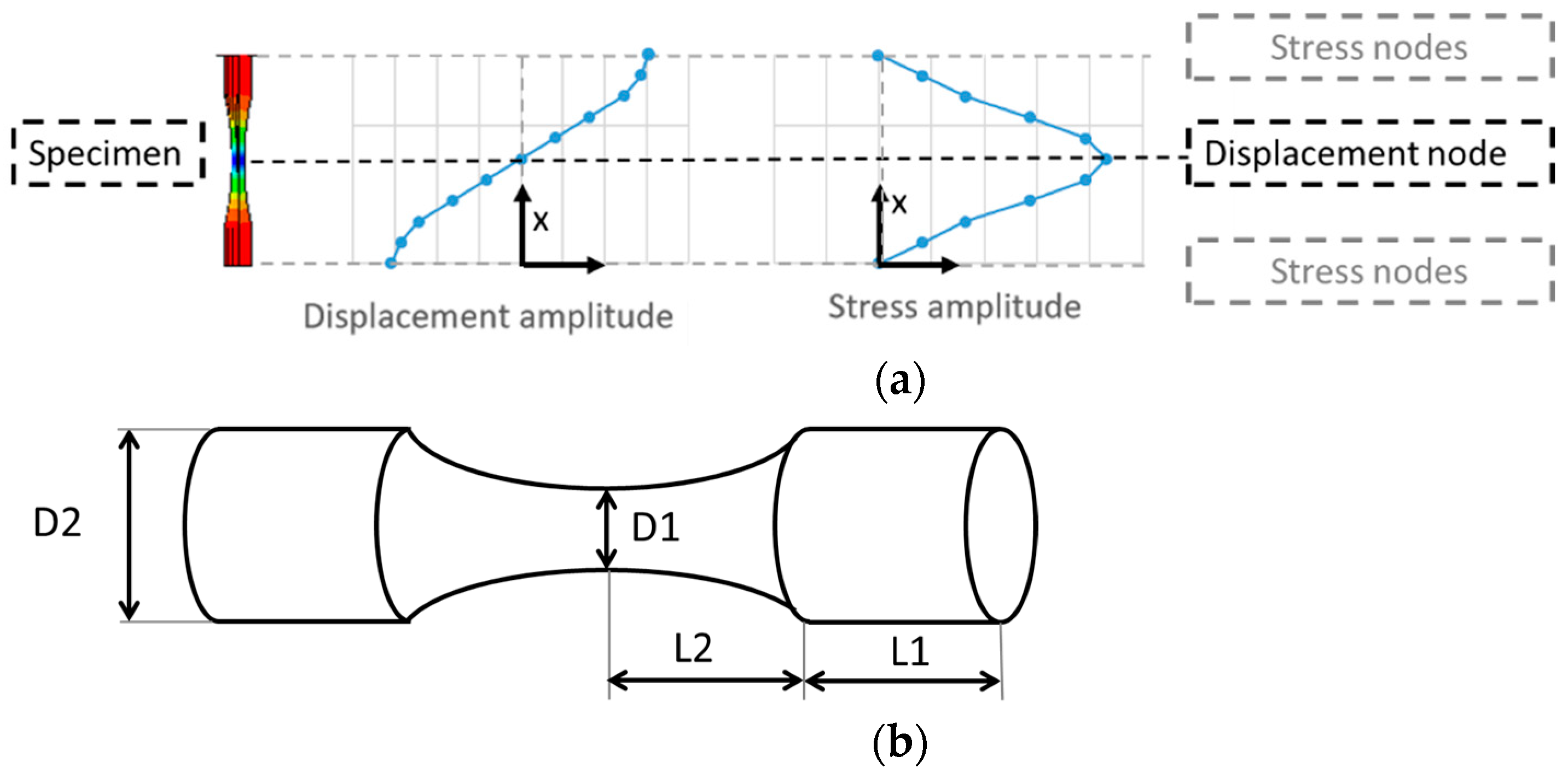
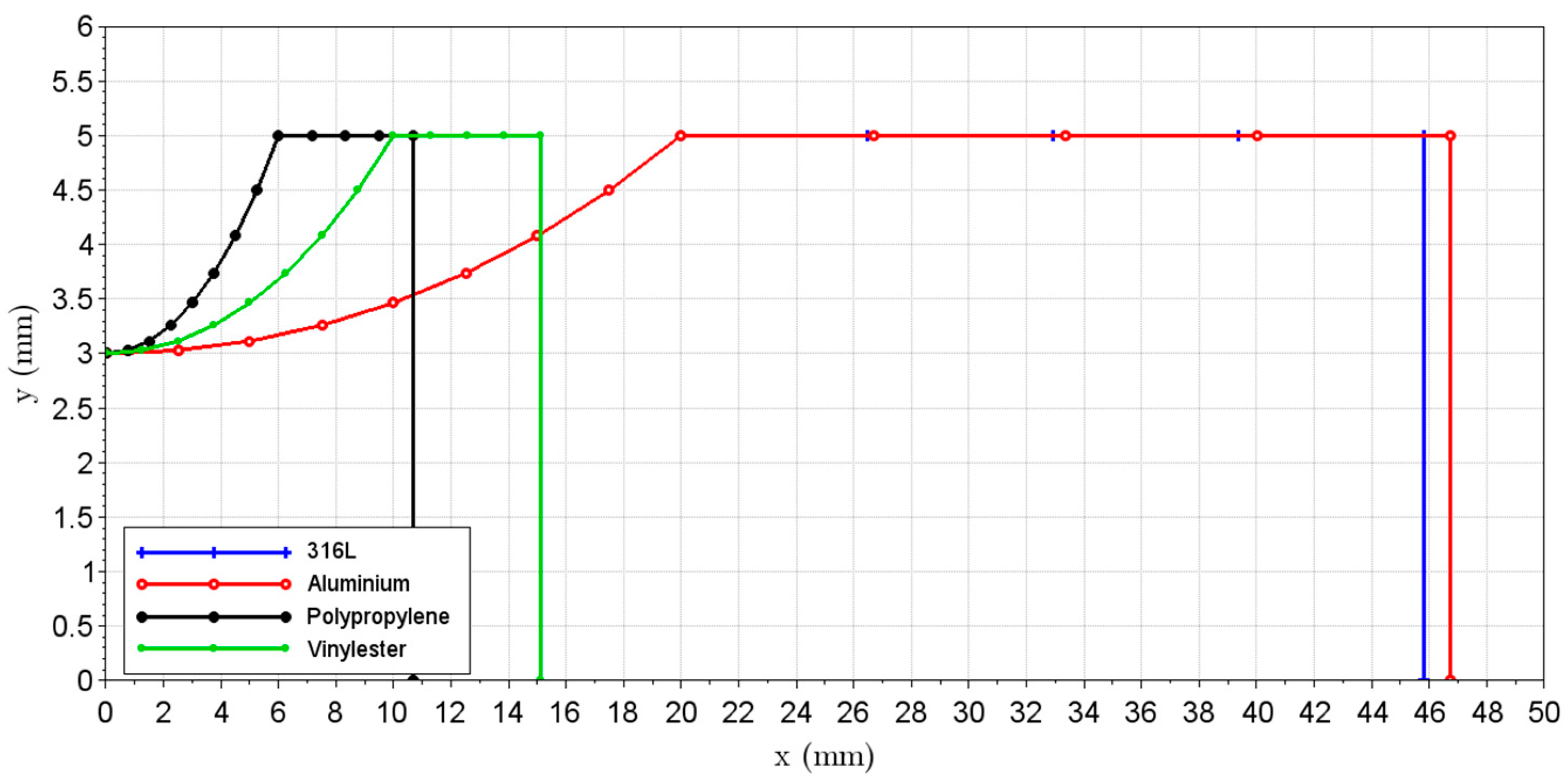
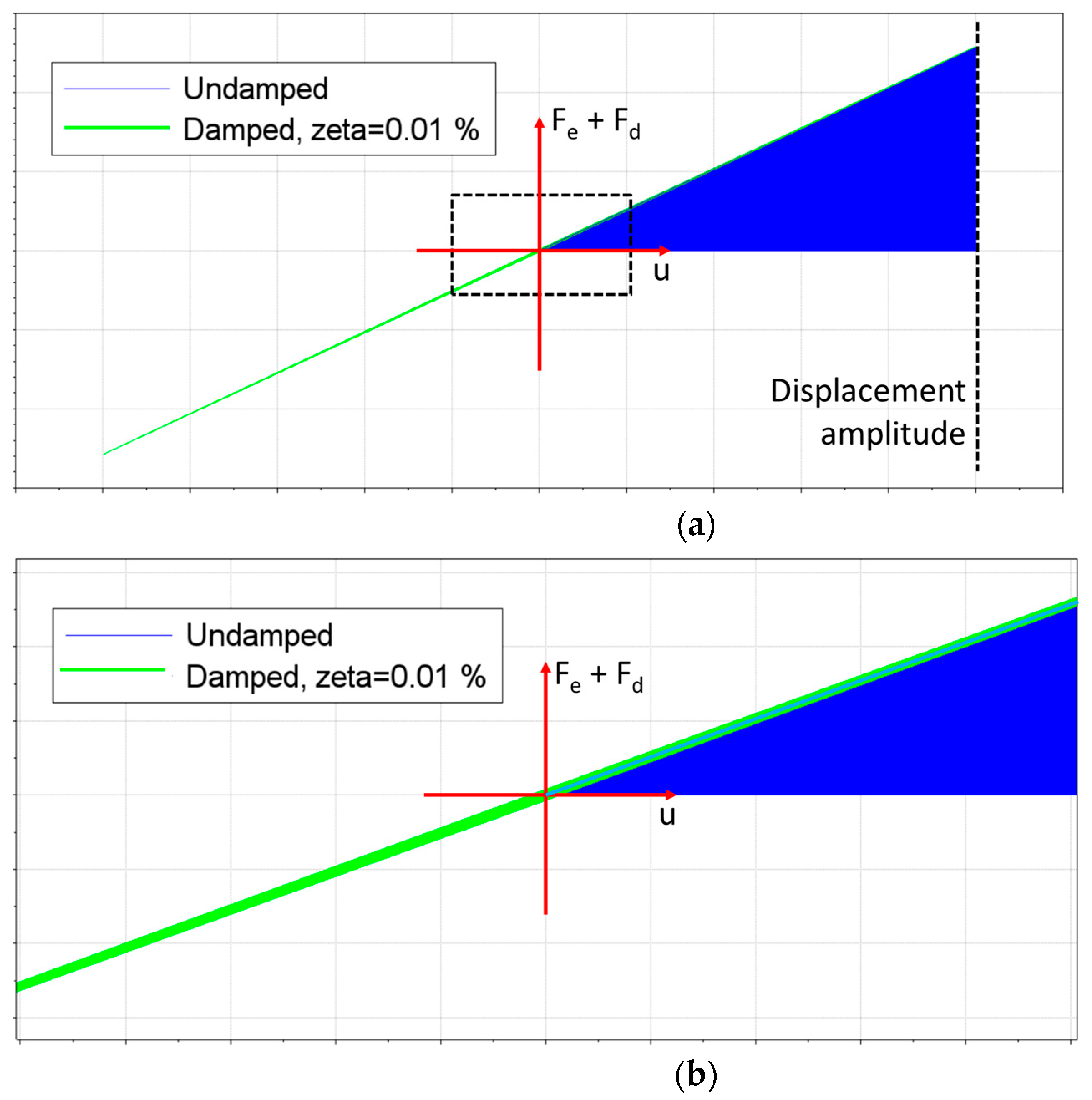

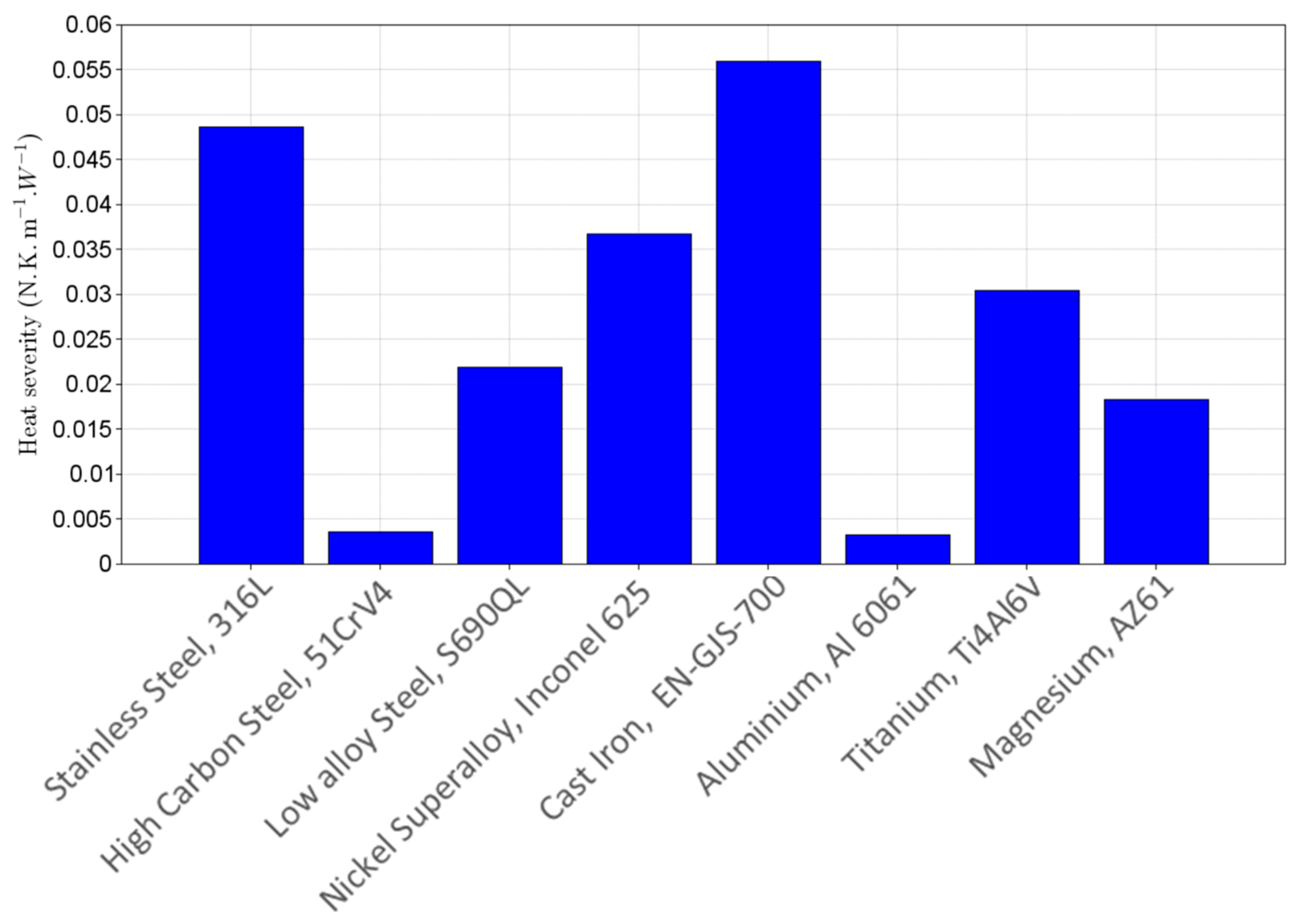

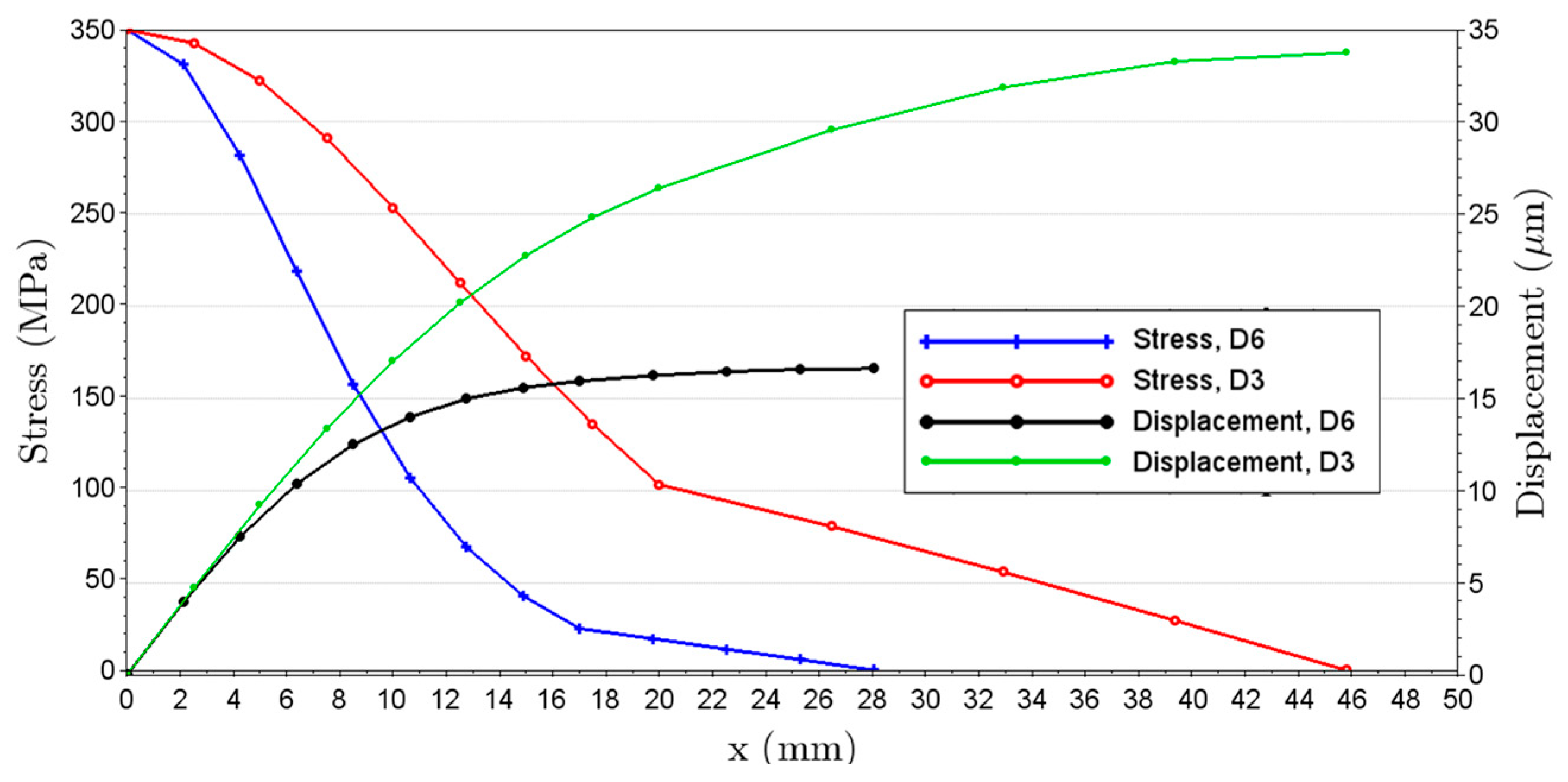



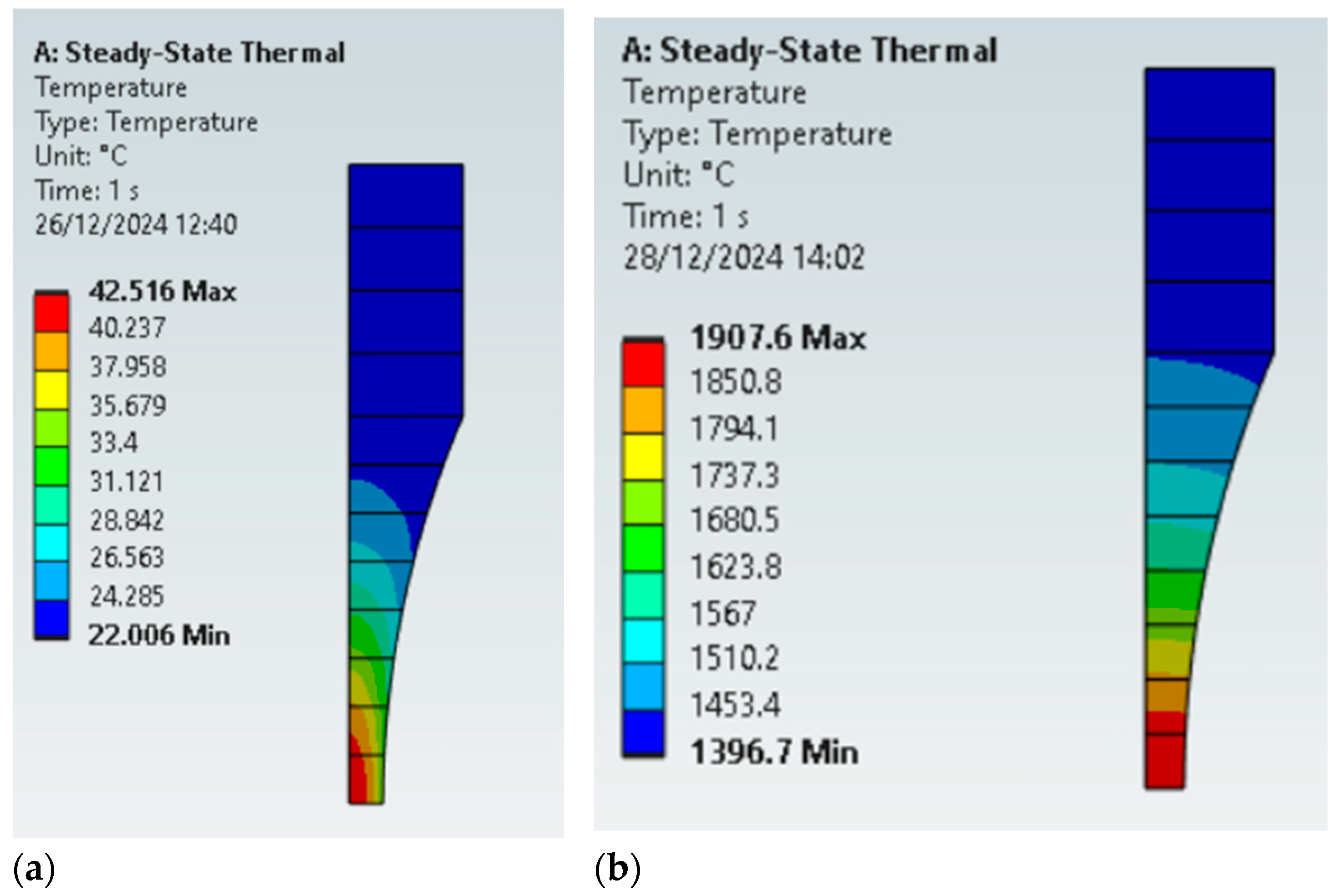


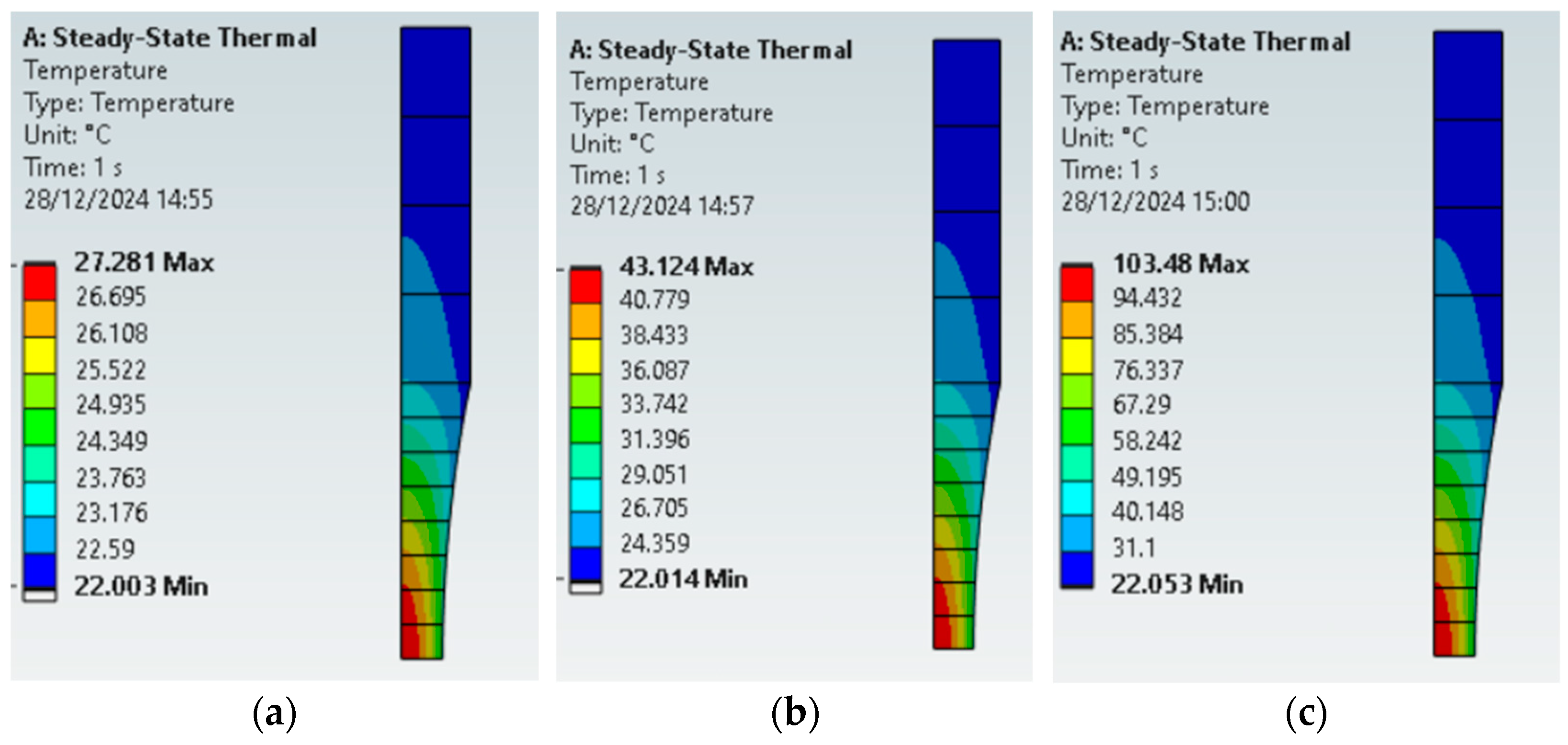
| Material | Flexural or Elasticity Modulus (GPa) | Density (kg/m3) |
|---|---|---|
| Steel [9] | 185.0 | 8000 |
| Aluminium [18] | 65.0 | 2700 |
| Polypropylene [19] | 1.2 | 910 |
| Vinylester [20] | 3.0 | 1120 |
| Material | Specimen Total Length (mm) | Maximum Stress (MPa), @ Max. Disp. of 50 μm |
|---|---|---|
| Steel | 91.6 | 350.0 |
| Aluminium | 93.4 | 121.6 |
| Polypropylene | 21.3 | 10.2 |
| Vinylester | 30.3 | 14.1 |
| Material | Thermal Conductivity (W⋅m−1⋅°C−1) | Loss Factor | Fatigue Limit (MPa) |
|---|---|---|---|
| Stainless Steel, 316L | 14 | 4.0 × 10−3 | 170 [23] |
| High Carbon Steel, 51CrV4 | 45 | 2.4 × 10−4 | 660 [24] |
| Low alloy Steel, S690QL | 19 | 8.0 × 10−4 | 520 [25] |
| Nickel Superalloy, Inconel 625 | 10 | 8.0 × 10−4 [9] | 450 [26] |
| Cast Iron, EN-GJS-700 | 31 | 6.0 × 10−3 | 290 [27] |
| Aluminium, Al 6061 | 167 | 5.6 × 10−3 [28] | 97 |
| Titanium, Ti4Al6V | 7 | 4.0 × 10−4 [29] | 510 |
| Magnesium, AZ61 | 70 | 8.0 × 10−3 | 160 [30] |
| Property | Value |
|---|---|
| Elasticity modulus (GPa) | 185 |
| Density (kg⋅m−3) | 7960 |
| Thermal conductivity (W⋅m−1⋅°C−1) | 10 |
| Damping ratio (%) | 0.2 |
| Ambient temperature (°C) | 21 |
| Convection coefficient (W⋅m−2⋅°C−1) | 10,000 |
| Excitation frequency (kHz) | 20 |
| Maximum stress amplitude (MPa) | 350 |
| Dimensions | Geometry 1, D6 | Geometry 2, D3 |
|---|---|---|
| D1 (mm) | 6.0 | 3.0 |
| D2 (mm) | 10.0 | 10.0 |
| L1 (mm) | 25.8 | 11.0 |
| L2 (mm) | 20.0 | 17.0 |
Disclaimer/Publisher’s Note: The statements, opinions and data contained in all publications are solely those of the individual author(s) and contributor(s) and not of MDPI and/or the editor(s). MDPI and/or the editor(s) disclaim responsibility for any injury to people or property resulting from any ideas, methods, instructions or products referred to in the content. |
© 2025 by the authors. Licensee MDPI, Basel, Switzerland. This article is an open access article distributed under the terms and conditions of the Creative Commons Attribution (CC BY) license (https://creativecommons.org/licenses/by/4.0/).
Share and Cite
Klein Fiorentin, F.; Dantas, R.; Wolfs Gil, J.; Piga Carboni, A.; Fiorentin, T.A.; de Jesus, A.M.P. On the Specimen Design, Physical Properties and Geometry Effect on Heat Generation and Thermal Gradient in Ultrasonic Fatigue. Machines 2025, 13, 380. https://doi.org/10.3390/machines13050380
Klein Fiorentin F, Dantas R, Wolfs Gil J, Piga Carboni A, Fiorentin TA, de Jesus AMP. On the Specimen Design, Physical Properties and Geometry Effect on Heat Generation and Thermal Gradient in Ultrasonic Fatigue. Machines. 2025; 13(5):380. https://doi.org/10.3390/machines13050380
Chicago/Turabian StyleKlein Fiorentin, Felipe, Rita Dantas, Jorge Wolfs Gil, Andrea Piga Carboni, Thiago Antonio Fiorentin, and Abílio Manuel Pinho de Jesus. 2025. "On the Specimen Design, Physical Properties and Geometry Effect on Heat Generation and Thermal Gradient in Ultrasonic Fatigue" Machines 13, no. 5: 380. https://doi.org/10.3390/machines13050380
APA StyleKlein Fiorentin, F., Dantas, R., Wolfs Gil, J., Piga Carboni, A., Fiorentin, T. A., & de Jesus, A. M. P. (2025). On the Specimen Design, Physical Properties and Geometry Effect on Heat Generation and Thermal Gradient in Ultrasonic Fatigue. Machines, 13(5), 380. https://doi.org/10.3390/machines13050380








